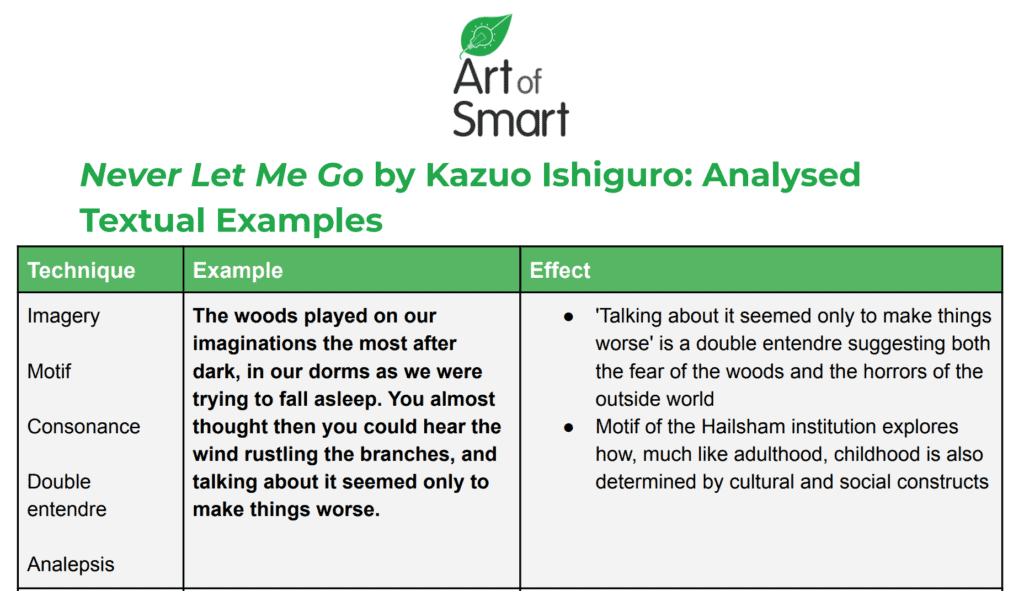Are you studying the book, Never Let Me Go, for English and struggling to come up with your analysis?
Don’t fret! We’re going to walk you through the key ideas of Never Let Me Go as well as give you a step-by-step of how to analyse the text.
PLUS we’ll provide you with a sample analysis table (also called a TEE table) and an example of a Band 6 paragraph for Never Let Me Go!
It’s time to ace your book analysis of Never Let Me Go — let’s go!
Never Let Me Go Book Summary
Key Characters in Never Let Me Go
Context
Themes Explored in Never Let Me Go
Book Analysis of Never Let Me Go
Book Summary of Never Let Me Go
Never Let Me Go is set in fictional late 1990s rural England, where cloned children raised and harvested for their organs through a nationwide organ donation system. The novel consists of three parts and is narrated by Kathy H, who explores her childhood at Hailsham boarding school, her early adulthood and the fate of Hailsham students.
Part One
Part One focuses on Kathy’s childhood and schooling at Hailsham. Hailsham appears, at first, like any normal British boarding school with large grounds, playing fields and, more importantly at Hailsham, art classes.
Kathy becomes friends with Ruth and Tommy. The trio contrast one another. Ruth is loquacious and the leader of her grade’s clique, while Kathy is timid. Tommy is an outcast of his grade due to his violent tantrums and lack of artistic ability — his art pieces are rarely chosen for the “special” Gallery selected by Madame, the co-founder of Hailsham along with Miss Emily (though, the students believe that Madame is the Head of Hailsham).
Tommy is called into Miss Lucy’s office, who reassures him to not worry about his creativity. Though he is relieved, he finds odd Miss Lucy’s anger during their conversation, particularly when mentioning the fate of the Hailsham students.
Kathy buys a cassette tape by a musician named Judy Bridgewater at the local school sales.
That night, Kathy is caught by Madame while Kathy dances slowly and holds an imaginary baby in her arms to the song titled “Never Let Me Go”. Madame starts to cry at this scene. Kathy later understands that, as a donor, she cannot have children.
Chapter 7 reveals the horror of Hailsham students’ fate. Miss Lucy says: Your lives are set out for you. You’ll become adults, then before you’re old, before you’re even middle-aged, you’ll start to donate your vital organs. That’s what each of you was created to do.
Tommy’s tantrums return. Kathy loses her cassette tape.
Part Two
In Part Two, the three friends are now in their last year at Hailsham. They move into the Cottages, where they prepare for their training as carers and donors. With the older Cottage students, Chrissie and Rodney, the five students take a weekend trip to Norfolk.
Rodney believes he has seen Ruth’s clone “parent” and follows her down to an art gallery, where they realise that it is not Ruth’s original. Ruth lashes out, saying: “We’re modeled from trash. Junkies, prostitutes, winos, tramps. Convicts, maybe, just so long as they aren’t psychos.”
Tommy has a new theory about deferring their careers as donors: if two Hailsham students were in love, and could prove it through their artwork, they could delay their donations by three or four years. He begins drawing imaginary animals in hope of the deferral theory. Ruth tells Kathy that she knows Kathy is in love with Tommy, but that he will never return her feelings.
Part Three
Part Three explores Kathy’s time as a carer. Kathy becomes a carer for Ruth, who has undergone two donations. They visit an abandoned fishing boat near Tommy’s treatment centre.
During the trip, Ruth admits that she had been keeping Kathy and Tommy apart and gives them Madame’s address to ask for a deferral.
Ruth passes away. Kathy becomes Tommy’s carer and they become a couple. They visit Madame’s address at a seaside town. Madame and Miss Emily are both living at the address. Miss Emily reveals that Hailsham was part of a progressive movement in England that promoted the welfare of clones and their raising. Madame tells Kathy and Tommy that their artworks at Hailsham were used to demonstrate that clones had souls. The deferrals were only a rumour among students and do not exist.
On their return trip, Tommy gets out of the car and has a tantrum. He dies after his fourth donation.
The novel ends with Kathy’s visit to Norfolk. She looks into a field and imagines that ‘this was the spot where everything I’d ever lost since my childhood had washed up, and I was now standing there in front of it, and if I waited long enough, a tiny figure would appear on the horizon across the field, and gradually get larger until I’d see it was Tommy, and he’d wave and maybe even call’.
Key Characters in Never Let Me Go
Kathy H
The narrator of Never Let Me Go and one of the clones who attended Hailsham boarding school. Kathy is 31 years old and works as a carer at the start of the novel. She is timid, forgiving and consistent throughout the novel.
Ruth
One of Kathy’s best friends. Unlike Kathy, she is temperamental and covers up her insecurities through charisma. At Hailsham, she pretends to have special privileges over other students.
Tommy
One of Kathy’s best friends and Ruth’s boyfriend for most of the novel. As a Hailsham student, he struggles with his tantrums and lack of artistic ability.
Madame
A co-founder of Hailsham boarding school. During Kathy’s Hailsham childhood, she takes the best student artworks to the “Gallery”, which is later revealed to be part of a progressive movement that advocated for the rights of clones.
Miss Emily
Head of Hailsham and co-founder of Hailsham. While the students found her strict, Miss Emily also advocated for the rights of clones through the Hailsham project.
Miss Lucy
A kind guardian at Hailsham who believes that the teaching methods at Hailsham do not prepare the students enough for their futures. She leaves Hailsham suddenly.
Context of Never Let Me Go
While the organ donation system and the “special” nature of the Hailsham characters seem distant, Ishiguro draws many parallels to the human injustices from our own world — many of which seemed like a widely recognised fact of life.
Thatcherism and 1990s England
Prime Minister Margaret Thatcher held her office from 1979—1990 and made significant changes to the future of British politics.
The years were marked with personal responsibility. This focus on individual freedom was initiated through greater independence from the state and meant heavy cuts to healthcare, public housing and education.
Thatcher’s definition of freedom soon ensued against the rising unemployment and social tension during the Thatcher years. This sparked a year-long strike from the Union of Mineworkers in 1984, wherein the miners ultimately lost and returned to work with no change to their work conditions.
The collapsing idea of freedom in the aftermath of Thatcherism is mirrored by how easily Kathy and the other clones resign to their fates: Why don’t the clones hide away? Why don’t the clones retaliate? How can they resist their fates?
Thatcher’s political focus on material wealth is further highlighted by the prestige of Kathy’s Hailsham upbringing. While her childhood is deemed a privilege to donors from other schools, she is still a donor and unable to save herself from the organ donation system.
Memoir and Science Fiction
Ishiguro’s Never Let Me Go blends popular literature genres from the 1990s.
The novel is narrated like a memoir, where the focus on the re-telling of childhood and schooling to preserve the memory of Ruth and Tommy reflects the success of the memoir genre during the early 1990s.
Along with using the techniques of memoir-writing, Ishiguro uses and subverts the genre of Science Fiction by inviting the reader to encounter an unfamiliar reality — though not of a distant futuristic planet, but in a dystopic version of rural England where bioengineering turns a blind eye from ethics.
Since the central protagonists are clones, the question of what it means to be human is emphasised when the reader fully comprehends the horror of the organ donation system and the clones’ fates. Here, Ishiguro’s use of the Science Fiction genre allows readers to draw parallels to our contemporary systemic and social issues that are often unspoken.
Themes Explored in Never Let Me Go
There are a wide range of themes you can explore in Kazuo Ishiguro’s Never Let Me Go. Here are three to spark your ideas:
- Loneliness
- What is human
- Status Quo
How to Analyse Never Let Me Go in 3 Steps
Often students will try to start with their thesis when trying to answer an essay question. Instead, start with your analysis! You need to equip yourself with the knowledge of your text before you can answer anything about it.
After you’ve analysed your text, you can draw ideas from it, then you can build your thesis!
We’re going to walk you through creating an analysis for ‘Never Let Me Go’ in three simple steps!
Step 1: Choose your example
The best way to choose an example is to find a technique. The technique is the key to unlocking deeper meaning in a text, which you will need in your analysis.
We have chosen to analyse Chapter 19 of Never Let Me Go when Ruth apologises for keeping Kathy and Tommy apart. We’ll use this scene to explore how Ishiguro explores how personal experiences of loneliness are often socially determined, rather than an inevitable feeling.
We all know it. We’re modeled from trash. Junkies, prostitutes, winos, tramps. Convicts, maybe, just so long as they aren’t psychos. That’s what we come from. We all know it, so why don’t we say it?
Step 2: Identify your technique(s)
When trying to find a technique within your example, it’s not about finding the fanciest technique or just any old technique for that matter!
It’s about identifying a technique which will enable you to say something about your idea that’s
interesting and can contribute to your argument and analysis.
Try to focus on finding examples with techniques which unveil a deeper meaning like metaphors, similes, figurative language, connotations, symbolism and recurring motifs. Other techniques like alliteration and repetition are a bit harder to find a deeper meaning in!
We have identified 4 techniques in Ruth’s outburst scene at Norfolk: lexical chain, connotations, motif, symbolism.
It’s always great to try and find multiple techniques in your quotes as it allows you to take your analysis up a notch!
Step 3: Write the analysis
When you write the analysis, it is important to always focus on what the effect of the technique is. One of the worst things you can do when writing analysis is technique labelling. Technique labelling would look like this:
During Ruth’s outburst at Norfolk, the lexical chain and negative connotations in the lines “We all know it. We’re modeled from trash. Junkies, prostitutes, winos, tramps.” is symbolic of how the clones are ostracised from the rungs of society.
Instead of this we need to flesh out how each of those techniques get us to our point. We need to show how these techniques make the audience feel. The phrase “negative connotations” is vague and we make it more specific to the feeling of unworthiness. We can also explore the theme of loneliness in more detail — for example, the clones’ loneliness is not self-inflicted, rather is caused by the organ donation system. So, if we include all that in our analysis, this is what it could look like:
During Ruth’s outburst at Norfolk, she states “we’re modeled from trash”, where the connotations of unworthiness are followed by the lexical chain “junkies, prostitutes, winos, tramps”; here, Ishiguro frames how loneliness is not be a universal fact of human condition, but an experience caused by a complex power structure — in this case, the organ donation system.
Need some help with your book analysis of other texts aside from Never Let Me Go?
Check out other texts we’ve created guides for below:
- Lord of the Flies
- 1984
- Jane Eyre
- In Cold Blood
- Persepolis
- To Kill a Mockingbird
- The Book Thief
- The Tempest
- Blade Runner
- Fahrenheit 451
Are you looking for some extra help with your book analysis of Never Let Me Go?
We have an incredible team of tutors and mentors!
We can help you master your book analysis of Never Let Me Go by taking you through the summary, context, key characters and themes. We’ll also help you ace your upcoming English assessments with personalised lessons conducted one-on-one in your home or online!
We’ve supported over 8,000 students over the last 11 years, and on average our students score mark improvements of over 20%!
To find out more and get started with an inspirational tutor and mentor, get in touch today or give us a ring on 1300 267 888!
Lynn Chen is a Content Writer at Art of Smart Education and is a Communication student at UTS with a major in Creative Writing. Lynn’s articles have been published in Vertigo, The Comma, and Shut Up and Go. In her spare time, she also writes poetry.











